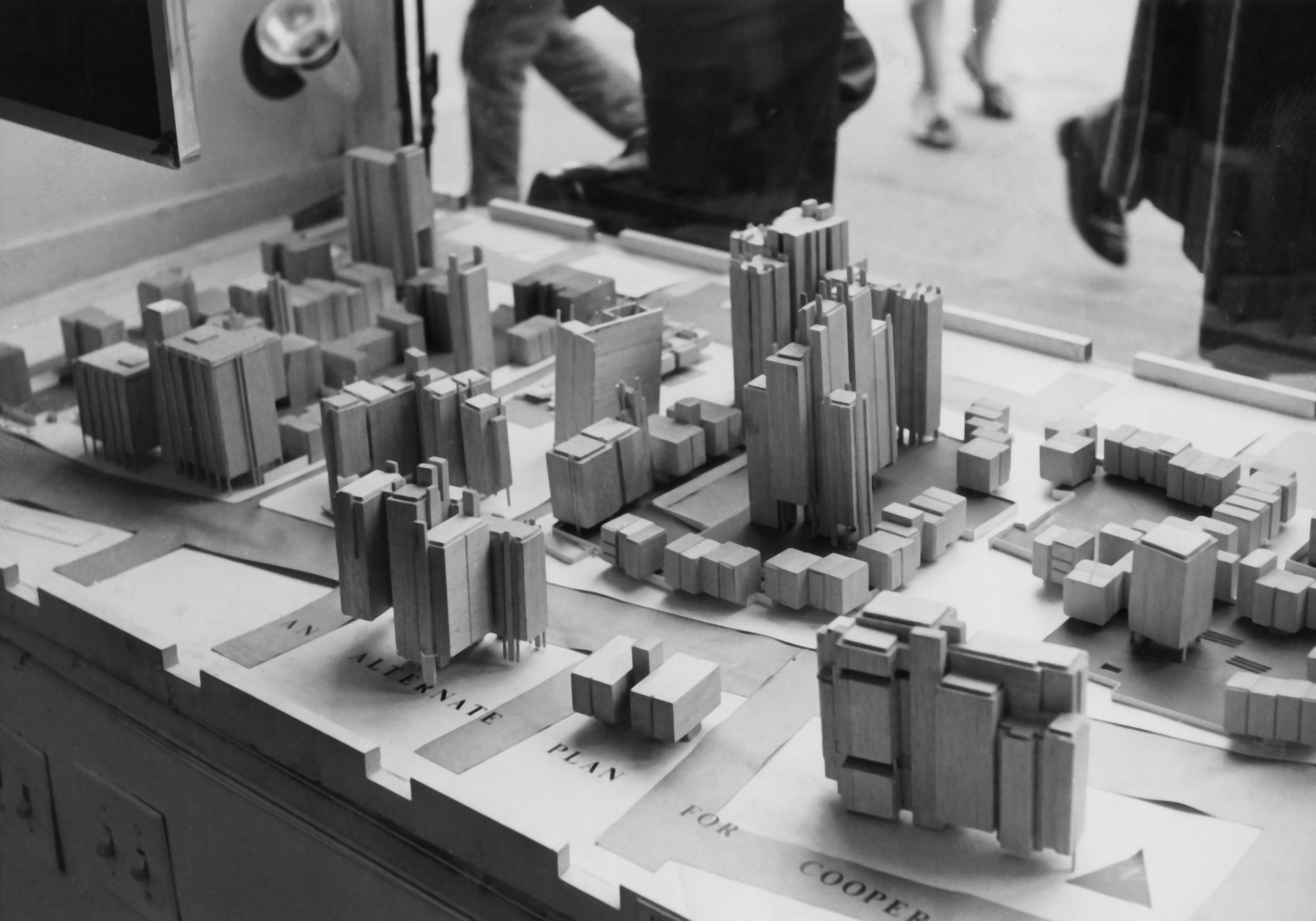Further Information
Cooper Square, NYC
Cooper Square is an area on the western perimeter of the Lower East Side of Manhattan. The area gets its name from Cooper Union, as well as the street and small park adjacent to the university’s main building.
In 1959 Robert Moses, Chairman of New York City’s Slum Clearance Committee, announced an urban renewal plan for Cooper Square. The plan would level nearly every residential building from 9th Street to Delancey Street and from 2nd Avenue to the Bowery, displacing an estimated 2,400 families and thousands of men living in single room hotels. Moses’ Cooper Square Plan, developed in conjunction with the United Housing Foundation, would have built over 2,000 middle-income co-op apartments in place of the tenements it razed.
Frances Goldin
Little did Moses know that he would meet his match in the Cooper Square Committee (CSC) and in Frances Goldin, the committee’s tenacious co-founder.
Frances Goldin was born into a working-class, Russian-Ukrainian Jewish family in Springfield Gardens, Queens in the 1920s. As a child, her family not only faced intense anti-Semitism, but they were also ostracized by the neighborhood’s merchant-class Jews because, as Goldin recalls, “my father went to work in overalls.” Her exposure to bigotry at an early age sowed the seeds for what would become a lifetime commitment to social justice.
At twenty, Frances married Morris Goldin and moved to the Lower East Side, an ethnically diverse and politically radical neighborhood, where she immediately felt at home. Following her husband, Frances Goldin joined the Communist Party. In 1951, at age 27, she ran for New York State Senate on an American Labor Party (ALP) slate headed by W.E.B. Du Bois, the premier Black intellectual of the time. For these and other political activities, the Goldins came under surveillance by the FBI and Morris was blacklisted, forcing Frances to become the family’s sole breadwinner.
In the 1950s, Frances was part of two unsuccessful efforts to stop urban renewal plans designed by Robert Moses: Lincoln Center and Seward Park. Experience in these campaigns would prove prescient in 1959 when an urban renewal plan was announced for the Cooper Square area, just blocks from Goldin’s apartment. In opposition to the Moses plan, Goldin and her neighbors formed the Cooper Square Committee (CSC) and launched a campaign to save their neighborhood.
Frances Goldin’s activism expanded beyond affordable housing. She advocated for women’s rights, labor rights, prison reform, LGBTQ rights, and she fought NYU’s expansion into the Lower East Side. Goldin was the founder of the Frances Goldin Literary Agency and has represented authors such as Barbara Kingsolver, Adrienne Rich, Dorothy Allision and political prisoner Mumia Abu Jamal.
The Alternate Plan for Cooper Square
An initial survey by the Cooper Square Committee (CSC) determined that 93% of the residents displaced by the Moses plan would not be able to afford the planned co-op units. In 1961, in collaboration with renegade urban planner Walter Thabit, the Cooper Square Committee released The Alternate Plan For Cooper Square. The Alternate Plan was an innovative mix of urban planning and direct democracy – and the product of over 100 community meetings. It is considered by many to be the first example of community-based planning in the United States.
The guiding principle of the Alternate Plan was that urban renewal should benefit, not displace, the existing residents of Cooper Square. The Alternate Plan called for “phased development”: building housing on vacant sites, then moving area tenants into those new apartments while housing was constructed on the newly vacant tenement blocks. In this way, the plan would assure that no existing resident of Cooper Square was displaced.
Robert Moses and the City of New York were unreceptive to the residents’ vision, but they had met their match. Led by Frances, the Cooper Square Committee backed their plan with a tenacious community organizing campaign which became increasingly militant throughout the 1960s. By 1971, exhausted and politically out-maneuvered by the community they had planned to displace, the City abandoned its urban renewal approach and agreed to let CSC implement the Alternate Plan.
The Cooper Square Mutual Housing Association and Community Land Trust
In the 1970s, the residents of Cooper Square faced a federal government divesting from low-income housing and a city facing financial collapse. Their focus shifted from developing new housing to saving their community from abandonment, arson and drug addiction. By the 1980s, a new phenomenon was displacing local residents and businesses: gentrification. The Cooper Square Committee (CSC) and their supporters realized a new approach was needed.
Building on international models and the legacy of land organizing in Black communities in the American South, the CSC eventually embraced a community land trust as the vehicle to preserve their community for the long term. After another prolonged organizing campaign, the City agreed to this approach: Cooper Square Mutual Housing Association and Cooper Square Community Land Trust were born.
In 2013, the community’s vision was finally realized with the approval of a 21-building mutual housing association and land transferred to the Cooper Square Community Land Trust.
Today Cooper Square stands as one of the few tangible examples of progressive, community-based planning in New York City. The Cooper Square CLT has inspired dozens of communities to create land trusts as a strategy to prevent displacement. Internationally, Cooper Square is renowned for its legacy of community organizing and for innovations in the CLT model to achieve permanently affordable low-income housing.


